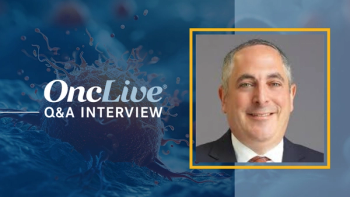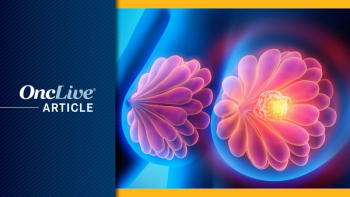
Fixed-Duration Ibrutinib Plus Venetoclax Demonstrates Efficacy in High-Risk CLL and SLL

The combination of ibrutinib and venetoclax administered for a fixed duration elicited durable responses and sustained progression-free survival in previously untreated, high-risk patients with chronic lymphocytic leukemia and small lymphocytic lymphoma, according to data from the phase 2 CAPTIVATE trial.
The combination of ibrutinib (Imbruvica) and venetoclax (Venclexta) administered for a fixed duration elicited durable responses and sustained progression-free survival (PFS) in previously untreated, high-risk patients with chronic lymphocytic leukemia (CLL) and small lymphocytic lymphoma (SLL), according to data from the phase 2 CAPTIVATE trial (NCT02910583) presented at the 2022 AACR Annual Meeting.1
In patients with high-risk features who received fixed-duration ibrutinib and venetoclax (n = 129), the overall response rate (ORR) was 98%, with a 56.6% complete response (CR) rate, a CR with incomplete blood count recovery (CRi) rate of 2.3%, and a partial response (PR) rate of 38.8%. Notably, of the 76 patients who achieved a CR or CRi, the duration lasted 12 or more treatment cycles in 87% of patients.
Among patients without high-risk features who were administered fixed-duration ibrutinib and venetoclax (n = 73), the ORR was 96%, with a 49.3% CR rate, 2.7 CRi rate, 42.5% PR rate, and a nodular PR (nPR) rate of 1.4%. Of the 38 patients who experienced a CR or CRi, 95% had a duration of response lasting 12 or more weeks.
“These results continue to support first-line therapy with ibrutinib/venetoclax, which is an all-oral, once daily, chemotherapy-free treatment approach that offers a fixed duration [and] provides clinically meaningful PFS and treatment-free remissions, despite the fact of high-risk genomic features,” lead study author John N. Allan, MD, an assistant attending physician at NewYork-Presbyterian Hospital and an assistant professor of medicine at Weill Cornell Medical College, said in the presentation.
Ibrutinib- and venetoclax-based regimens have demonstrated a PFS benefit over chemoimmunotherapy in patients with previously untreated CLL and SLL and high-risk genomic features that confer inferior outcomes with chemoimmunotherapy. These genomic features include 17p deletions, TP53 mutations, and unmutated IGHV. Previous data from a phase 2 trial (NCT02756897) showed the addition of venetoclax to ibrutinib produced promising efficacy in patients with previously untreated CLL who harbored at least 1 high-risk genomic feature.2
CAPTIVATE enrolled patients between the ages of 18 and 70 years with previously untreated CLL or SLL.
In the fixed-duration cohort, patients received 3 lead-in cycles of ibrutinib at 420 mg per day, followed by 12 cycles of ibrutinib plus oral venetoclax, which was ramped up to 400 mg per day. In the MRD cohort, patients received the same treatment before being randomized based on MRD status. Patients with confirmed undetectable MRD were randomized to ibrutinib or placebo, and patients with unconfirmed, undetectable MRD were randomized to ibrutinib with or without venetoclax.
For the pooled analysis of the fixed-duration cohort, patients with undetectable MRD who were randomized to receive placebo were also included (n = 43).
The primary end point of the fixed-duration cohort was CR rate. Secondary end points for the fixed-duration cohort were ORR, duration of response (DOR), MRD-negativity rate, tumor lysis syndrome risk reduction rate, PFS, overall survival (OS), and safety.
Of all patients enrolled in the fixed-duration cohort, 64% had high-risk features. Among the patients with high-risk features in the fixed-duration cohort, the median age was 60 years (range, 33-70), and 66% of patients were male. Notably, 28% had Rai stage III or IV disease. High-risk features included unmutated IGHV (92%); 17p deletion and TP53 mutation (22%); 17p deletion (16%); 11q deletion (26%); and complex karyotype (21%).
Additionally, 36% of patients had any cytopenia, including an absolute neutrophil count ≤1.5 x 109/L (8%); hemoglobin ≤11 g/dL (31%); and platelets ≤100 x 109/L (8%). Moreover, 36% of patients had a lymph node diameter of at least 5 cm, and the median absolute lymphocyte count was 67 x 109/L (range, 1-503). The median time on study for patients with high-risk features was 28.7 months (range, 0.8-45.1).
Specifically in patients with both 17p deletions and TP53 mutations (n = 29), the ORR was 97%, with a 52% CR/CRi rate. In patients with unmutated IGHV (n = 100), the ORR was 98%, with a 61% CR/CRi rate.
Among high-risk patients, 88% and 72% had undetectable MRD in the peripheral blood and bone marrow, respectively. In patients without high-risk features, undetectable MRD rates in the peripheral blood and bone marrow were 70% and 62%, respectively. Specifically in patients with 17p deletions and TP53 mutations, the undetectable MRD rates in the peripheral blood and bone marrow were 83% and 45%, respectively, and in patients with unmutated IGHV, the rates were 90% and 80% in the peripheral blood and bone marrow, respectively.
Additional results showed that ibrutinib plus venetoclax led to a 24-month PFS rate of 94% (95% CI, 88%-97%) in patients with high-risk features compared with 97% (95% CI, 89%-99%) in patients without high-risk features. The 24-month PFS rate for patients with 17p deletions and TP53 mutations was 85% (95% CI, 65%-94%); this rate was 96% (95% CI, 90%-99%) in patients with unmutated IGHV.
The 24-month OS rate in patients with high-risk features was 98% (95% CI, 93%-99%) vs 100% (95% CI, 100%-100%) in patients without high-risk features. The 24-month OS rate was 96% (95% CI, 77%-99%) in patients with 17p deletions and TP53 mutations compared with 98% (95% CI, 92%-99%) in patients with unmutated IGHV.
Regarding safety, the most frequent grade 3 or 4 adverse effects (AEs) were neutropenia (29% and 34% in the high-risk patients and non–high-risk patients, respectively); hypertension (9% and 3%); and decreased neutrophil count (7% and 1%). AEs of clinical interest of any grade included atrial fibrillation (6% and 4%) and major hemorrhage (2% and 1%). Serious AEs were reported in 22% of both high-risk and non–high-risk patients.
AEs leading to treatment discontinuation were reported due to ibrutinib only (2% and 3% in the high-risk and non–high-risk patients, respectively), venetoclax only (0% and 0%), and both ibrutinib and venetoclax (1% and 3%). Additionally, dose reductions were reported for ibrutinib only (7% and 4%), venetoclax only (11% and 12%), and both agents (2% and 5%).
Notably, 94% of patients completed 12 cycles of fixed-duration ibrutinib plus venetoclax. The median duration on treatment was 13.8 months (range, 0.7-24.9) for ibrutinib and 11.1 months (range, 9.9-22.1) for venetoclax.
References
- Allan JN, Flinn IW, Siddiqi T, et al. Fixed-duration ibrutinib + venetoclax for first-line treatment of chronic lymphocytic leukemia in patients with high-risk features: phase 2 CAPTIVATE study. Presented at: 2022 AACR Annual Meeting; April 8-13, 2022; New Orleans, LA. Accessed April 11, 2022. Abstract CT028.
- Jain N, Keating M, Thompson P, et al. Ibrutinib plus venetoclax for first-line treatment of chronic lymphocytic leukemia: a nonrandomized phase 2 trial. JAMA Oncol. 2021;7(8):1213-1219. doi:10.1001/jamaoncol.2021.1649

























































































